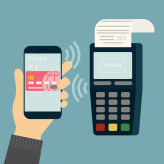 As the latest technology permeates the business world to an ever greater extent, consumers are increasingly turning to mobile payment platforms for the ease and convenience they offer in settling up without fumbling around for coins, notes and cards. And businesses that adopt these new technologies are the ones that are cleaning up with increased client conversion and retention, sales, and profit. The latest development in the mobile payment platform sector is the announcement of Google’s Android Pay platform – here’s what you need to know.
As the latest technology permeates the business world to an ever greater extent, consumers are increasingly turning to mobile payment platforms for the ease and convenience they offer in settling up without fumbling around for coins, notes and cards. And businesses that adopt these new technologies are the ones that are cleaning up with increased client conversion and retention, sales, and profit. The latest development in the mobile payment platform sector is the announcement of Google’s Android Pay platform – here’s what you need to know.
When Google launches Android Pay, it will act as more than just another app like Apple Pay, or Google’s existing Wallet app (which will continue to be in use, and will be powered by Android Pay). This means it will be useful to developers and retailers looking to allow users to make payments for products and services from right within their apps on Android devices.
Apple technology already enables iPhone users to buy goods in real-life stores using near-field communication (NFC), and Google’s Android Pay system will do the same. A similar technology to Apple’s is Google’s local storage of bank card information, which takes away the need for you to have a phone signal to make payments. There are also benefits to security – another feature that Android Pay will adopt from its rival is the use of one-time, automatically generated credit card numbers for each transaction. This helps to fight fraud because even if the retailer you shop with subsequently suffers a data breach, any card numbers the fraudsters get hold off would have expired already.
Google ultimately hopes that its Android Pay system will also include support for fingerprint scanning and other security features, further boosting the peace of mind you can have while using it to shop and settle up.
Competition is beefing up in the mobile payment platform arena. While Google Wallet failed to gain much traction when it first launched in 2011 – it was considered by many to be ahead of its time – the recent growth of Apple Pay appears to have revived hope in the Google alternative. What’s more, Samsung recently debuted Samsung Pay, which is big on payment security and will come as default on the latest models of the Galaxy and Edge range of devices. The Samsung system has the potential to quickly achieve far greater reach since, while Apple Pay only works where retailers already have NFC installed, Samsung recently acquired the firm LoopPay, and as a result Samsung Pay will also support the use of conventional magnetic credit card readers.
And even PayPal is moving in on mobile payment territory. Though the company has for some time had its own apps that make it easy to send cash to friends or suppliers, or to make purchases at participating retailers, PayPal is still better known for its web-based payments system. However, PayPal recently acquired Paydiant, a startup due to launch later in 2015 with a competitor to all the other mobile payment platforms, known as CurrentC. It could prove stiff competition indeed, since it’s backed by retailers like Wal-Mart and 7-Eleven.
Don’t be fooled into thinking that your business can ignore the rapid growth of mobile payments. To find out how to leverage them to your benefit, get in touch with us today.